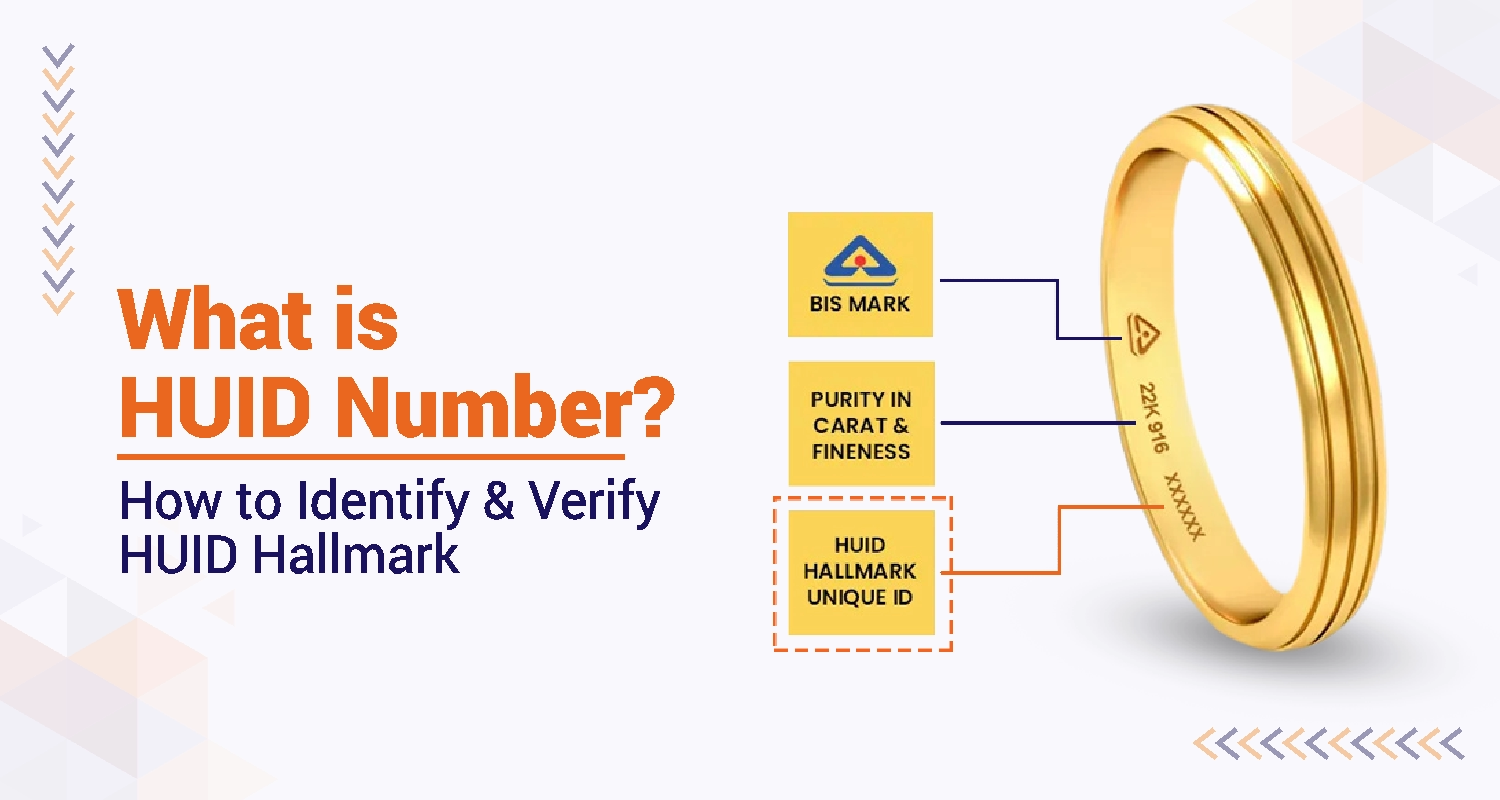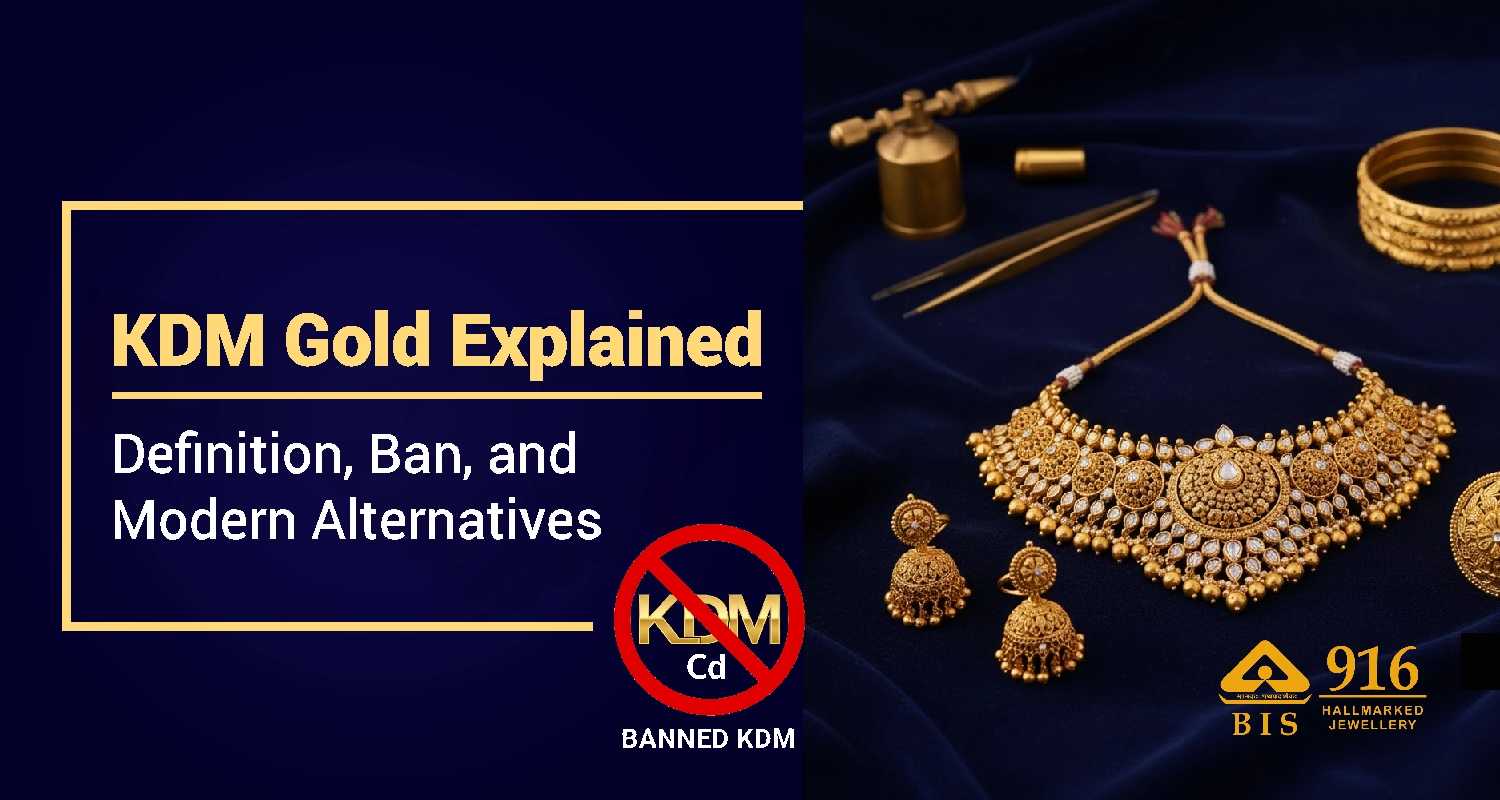How to Check Gold at Home: DIY Purity Tests You Can Try

If you are planning on buying or selling gold jewellery, it would be a good idea to understand how to check gold purity at home. After all, gold is not just a precious metal; it’s a major financial investment and a symbol of wealth. Nowadays, there are multiple cases of counterfeit and imitation pieces doing the rounds. Hence, verifying authenticity can save you from costly mistakes. Even though getting your gold professionally tested at certified jewellers is the most reliable method, there are also simple techniques that you can try at home.
Common Hallmarks to Identify Real Gold
Hallmarks are an essential step in confirming the authenticity of your gold. In India, the BIS (Bureau of Indian Standards) mark is the most widely trusted and accepted name, showing both purity and certification.
- Key Hallmarks:
- BIS logo
- Numeric purity indicator (e.g., 916 for 22K, 750 for 18K)
- Assayer’s identification mark
- How to Read Hallmarks:
- Look for purity number and logo together.
- Ensure markings are clear and match official BIS records.
- Cross-check jewellery certificates for verification.
Properly understanding hallmarks reduces the risk of buying counterfeit gold and ensures reliable valuation.
Understanding Gold Purity and Karat System
Gold purity is measured in karats (K), where 24K represents pure gold (99.9% purity). Lower karats like 22K, 18K, or 14K indicate that alloys such as copper or silver have been added to increase strength.
- Karat Numbers and Purity Percentages:
- 24K: 99.9% pure
- 22K: 91.6% pure
- 18K: 75% pure
- 14K: 58.3% pure
- Why Purity Matters:
- Investors rely on purity for accurate valuation.
- Gold purity affects eligibility and amount of gold loans.
- Jewellery durability and resale value are linked to karat levels.
Testing Methods to Check Gold Purity at Home
While professional testing is always the most reliable, these simple at-home methods can help you identify whether your gold is real or fake.
1. The Float Test: A Simple Approach to Check Gold Purity
The float test is a straightforward method that utilises the density difference between gold and other metals. Using this method, you can test gold at home. To perform this test, fill a container with water and gently place the gold item you want to test into the water. Observe the behaviour of the gold:
If the gold sinks: This indicates that the item is likely genuine gold, as pure gold has a high density and will sink in water.
If the gold floats or hovers: This suggests that the item is not pure gold and may contain a significant proportion of lighter metals.
Get Gold Loan at the comfort of your home
Apply Now2. The Magnet Test: Assessing Gold's Magnetic Properties
Gold is non-magnetic, meaning it will not be attracted to a magnet. This property can be used to distinguish gold from base metals, which are often magnetic. Hold a strong magnet near the gold item you want to test. If the magnet attracts the item, it is likely not pure gold.
3. The Acid Test: A Cautionary Approach for High-Purity Gold
The acid test, also known as the nitric acid test, involves applying a drop of nitric acid to the gold item. This test is most effective for high-purity gold, typically 22 karats or higher. Observe the reaction:
If the acid turns green or blue: This indicates that the item is likely not pure gold and contains a significant amount of copper or other base metals.
If the acid leaves a reddish-brown mark: This is a sign of lower-purity gold, typically 18 karats or less.
If the acid leaves no mark: This suggests that the item is likely pure gold, as gold is resistant to nitric acid.
4. The Scratch Test (Ceramic Plate Test)
The scratch test is a quick and straightforward method to check the genuineness of your gold. For this method, you will need an unglazed ceramic plate. Simply rub the gold item gently against the surface of the plate and observe the streak it leaves:
- If the streak is gold-colored: This suggests the item is real gold.
- If the streak is black or gray: The item is likely fake or there is some impurity involved or made of another metal.
This test is simple and doesn’t require chemicals, but one has to be cautious. Scratching can slightly damage the surface of your jewellery.
5. Visual Inspection: Looking for Hallmarks and Signs of Wear
Carefully examine the gold item for any hallmarks or markings. Genuine gold jewellery often bears a hallmark indicating its purity, such as "916" for 22 karat gold or "18K" for 18 karat gold. Additionally, you must look for wear and tear. Pure gold is relatively soft and can scratch easily. Suppose the item has a hallmark that indicates its purity, but it also appears worn or scratched. In that case, it is still possible that the item is pure gold. To Stay informed learn how to check hallmark on gold6. Professional Grading: Seeking Expert Confirmation
If you have concerns about the authenticity of a valuable gold item, consider seeking professional grading from a reputable jeweller or appraiser. They have the expertise and tools to conduct more comprehensive tests and provide a definitive assessment of the gold's purity and value.
Checking gold at home can be a convenient and effective way to verify its authenticity and purity. While the methods discussed provide valuable insights, it is important to note that they are not fool proof. Professional grading remains the most reliable method for determining the true value and authenticity of gold, especially for high-value items.
Safety Tips When Testing Gold at Home
Testing gold at home requires care to avoid injury or damage to the jewellery.
- Precautions for Acid and Scratch Tests:
- Always use protective gloves and eye gear.
- Conduct tests on non-porous surfaces to prevent spills.
- Follow instructions on testing kits carefully.
- Recommended Environment:
- Work in a well-ventilated area.
- Avoid performing tests near children or pets.
- Use appropriate containers for acids to prevent accidents.
By following these precautions, home testing can be safe and effective without risking health or jewellery.
Conclusion
Knowing how to check gold at home offers a convenient and accessible first step for anyone who owns gold jewellery or investment pieces. While no single test can guarantee accuracy on its own, combining a few simple methods such as the magnet test, scratch test, or acid test can give you stronger confidence in your gold’s authenticity. However, when it comes to valuable or investment-grade items, professional verification remains the gold standard to ensure complete peace of mind.
Get Gold Loan at the comfort of your home
Apply NowFrequently Asked Questions
Some of the easiest methods to check the purity of gold at home include the magnet test, the scratch test (using a ceramic plate), the float test, and the acid test. These tests can provide you with quick insights into whether your gold is genuine.
Home gold testing methods do provide useful indications; however, they can’t be 100% reliable. Factors like surface coatings or impurities can affect results. For complete accuracy, professional testing is always recommended.
No, relying on a single test is not advisable. If you combine multiple methods to check gold at home, you might get more substantial confidence about your gold’s authenticity.
If your item is of high value, especially one meant for investment, or shows mixed results in home tests, it’s best to have it professionally verified by a certified jeweler.
You should avoid harsh methods that can damage your gold, such as excessive scratching or using strong chemicals without care. Always test gently and prioritize professional evaluation for precious items.
No, the magnet test only shows if gold is magnetic. Pure gold is non-magnetic, but some fake or plated items may pass or fail inconsistently. It is not a definitive test for gold purity and should be used alongside other testing methods.
Acid testing at home can cause skin burns, eye injury, or damage to jewellery if not handled properly. Always use gloves, goggles, and work in a well-ventilated area. Follow instructions carefully to avoid accidents and ensure that your gold remains unharmed during testing.
Gold purity marks indicate parts per thousand: 916 = 22K (91.6% pure), 750 = 18K (75% pure), 585 = 14K (58.5% pure). These marks, often accompanied by a hallmark, confirm the gold’s authenticity and help buyers and investors assess its true value.
No, household acids like vinegar are unreliable for testing gold. They cannot accurately determine purity and may damage jewellery. Only certified acid testing kits or professional evaluation at a jeweller can provide reliable results.
Hallmarks indicate authenticity and purity. Look for the BIS logo, purity number (like 916, 750), and assayer’s mark. Clear and matching hallmarks confirm that the gold meets regulatory standards and can be trusted for investment, resale, or loan purposes.
A certified acid testing kit designed for 14K, 18K, 22K, and 24K gold is ideal. These kits include testing acids, stones, and instructions. They allow safe, accurate, and convenient home testing of gold purity without damaging your jewellery.
Banks and NBFCs usually accept 18K and above for gold loan collateral. Higher purity, like 22K, is preferred for better loan valuation. 18K gold is widely accepted as it balances durability and value, ensuring smooth approval and disbursal.
Disclaimer : The information in this blog is for general purposes only and may change without notice. It does not constitute legal, tax, or financial advice. Readers should seek professional guidance and make decisions at their own discretion. IIFL Finance is not liable for any reliance on this content. Read more



